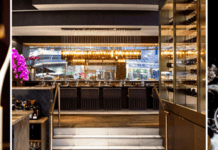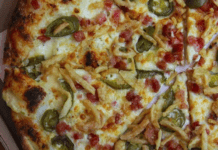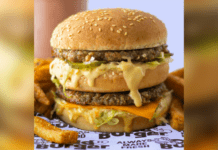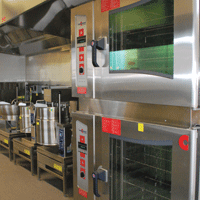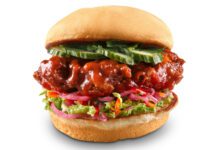Chefs are passionate about ovens and stovetops, often choosing favourites based on the size of an operation.
Who knew the subject of ovens and stovetops could be so polarizing. There are the die-hard, back-to-basics chefs who covet their tried-and-true ovens, and there are those with a passion for technological innovation.
Toronto’s Mark McEwan is old-school when it comes to choosing ovens for his restaurants and retail grocery operations. “I don’t use induction. I don’t use combi-ovens. I try to keep my equipment as heavy duty and simple as possible. I prefer the good old-fashioned way of cooking that is enhanced by equipment and not abbreviated by it. So durability is very much a factor.” His current picks are Garland and Imperial ovens as well as one wood-burning stove at his Fabbrica restaurant that came from Naples, Italy.
Ross Midgley, executive chef of the soon-to-be-opened Jamie Kennedy on the Falls (JKF) in Niagara Falls, Ont., is also a back-to-basics kind of chef. “I just need a good oven that holds a consistent heat.”
Right now the new restaurant is looking at two Garland still ovens and a convection oven with dual-fan speeds. “Convections aren’t good for a lot of pastries and desserts, but they’re quite useful for roasting larger joints of meat because the air is continuously circulating, which ultimately saves energy.” Besides, with only 90 seats to fill, “We don’t have the same demand for some technologies being offered,” he says.
Turn the dial 180 degrees and you’ll find Geoffrey Morden, executive chef for the Ottawa Convention Centre. Having worked in large-scale hotel operations for many years, this toque is no stranger to high-volume cooking needs. His new kitchen boasts 12 new Rational combi-ovens, which ring in at approximately $50,000 apiece. He says the sophistication actually makes his job easier, because the controls allow him to perform a variety of tasks, from steaming and reheating to braising and stewing. “They’re fantastic for mass production, because they’re so diverse.”
The reason for the dichotomy in thinking makes sense. Desired features and functions tend to reflect the environment they serve and the menus the chefs create. A small 90-seat fine-dining restaurant that prides itself on its individualized cooking approach has no use for a computerized system that churns out hundreds of identical finished products; but when you have a guest list of thousands, it makes perfect sense.
The education factor
Perhaps the most balanced perspective is found at colleges where chefs spend their time working with a range of technologies to reflect different environments.
Mikael Volke, culinary instructor for the SAIT Polytechnic School of Hospitality and Tourism in Calgary, reports that the school has an impressive and growing collection of induction, Rationals, Alto Shaams, slow cookers, holding ovens and even microwave ovens specifically designed for baking bread. “Students have to know how to operate in all sorts of environments,” he says.
“Our job is to teach what the industry is looking for,” confirms Hans Anderegg, chef instructor for the Culinary Institute of Canada in Charlottetown. Students get to play with a whole range of technologies from “plain ovens” to combis to speed cookers.
Even within a category, such as combi-ovens, they like to showcase different brands so students can work with them all. “We have Rationals and Combitherms, simply because not every restaurant has the same brand.”
The fear factor
A lot of chefs admit to anxiety about the digitization and maintenance challenges that go with technology. “The more bells and whistles, the greater the probability it can let me down,” says JKF’s Midgley. “We have to depend on our ovens to work all the time. With gas, the problems might be a pilot light issue, but any cook can light an oven.”
David Zabrowski, director, Engineering for the Foodservice Technology Center in San Ramon, Calif., contends that digitization is not usually the issue. “The number-1 cause of service failures, particularly with combis, goes back to installation. A proper installation must observe the specs for clearances regarding hot surfaces, floor drains, et cetera, because the electronics are sensitive. Put a combi too close to a charbroiler and the control panel will have problems.”
Water treatment is also important. “[If you use] anything with a boiler in the system, you need to ensure the water is properly filtered, treated and de-limed.”
The energy factor
Whether a chef is old-school, new-school or treads the line, there is one common thread, Zabrowski says. “There’s a greater emphasis on energy efficiency all around because of rising energy costs, rebate programs from utilities and operator demands. Manufacturers are being forced to rethink design to reduce energy consumption while maintaining the same baking performance. This is particularly important with respect to LEED [Leadership in Energy and Environmental Design] and institutions applying for stimulus money.” He reports standard oven efficiency — on equipment that isn’t Energy-Star rated — is at about 30 per cent. “That means 70 per cent of energy is wasted.”
When it comes to energy efficiency in ovens there are three functions to consider: good heat transfer, insulation and burner efficiency. “Basically that means good door seals and better insulation materials with better properties,” explains Zabrowski.
The biggest energy-saving push has been in combi-ovens, he adds. “These are very efficient and getting better all the time. A lot of work has been done on better seals around doors and improving insulation to keep heat in. We’re seeing that carry over into larger baking ovens to reduce venting needs and retain more heat.”
Rational has pushed the envelope further with the launch of its SelfCookingCenter whitefficiency, which is said to increase capacity by 30 per cent, reduce cooking time by 30 per cent and lower energy, water and cleaning chemical consumption by 40 per cent over conventional combi-steamers. Other innovations on the oven front include standby controls that allow the appliance to ‘go to sleep’ to retain the stored heat; this allows the units to stay warm without using energy, enabling a faster startup.
As an organization dedicated to promoting energy efficiency, the Technology Center has been a strong proponent for induction technology for 20 years, Zabrowski adds. “Induction offers a strong potential for improved energy efficiency, particularly with respect to cooktops. An induction cooktop is 80- to 90-per-cent efficient, compared to 70 per cent for a standard electric range and 30- to 40-per cent efficient for an open gas burner range. Induction also senses if cooking utensils are present and uses very little energy [just controls and a cooling fan] when there’s no pot or pan.”
He notes that the biggest hurdle in the past for induction has been the relatively high initial cost. “Now that more companies are offering induction units, and the cost of the components has begun to drop, it is our hope that it will become a more viable option for operators.”
Zabrowski reports, however, that these energy-saving innovations aren’t happening so much on the convection front. “Right now there is huge pressure to keep convection prices as low as possible, which forces manufacturers to stay simple, basic, low-tech and inefficient. We are however getting wind of some new, more efficient designs coming from major manufacturers, including Moffat out of New Zealand.”
Whether it’s back-to-basics or cutting-edge, it’s all about knowing what you’re dealing with. “Some chefs don’t like technology, and that’s fine,” says Morden, of Ottawa’s Convention Centre. “For me it’s a matter of getting used to it and embracing it. I have to say, it’s nice to be able to have cool toys.”
More in Feature Articles
Foodservice Trend Report 2012 (Food, Operations, Technology, Social Media, Greening)
Thoughts on Restaurant Valuations
Analyze This: Corn and Potato Pancakes With Tomato Relish (Recipe by Jamie Kennedy)
The Tracker: Smart Inventory Technology
Smooth Sailing: Profiling Chef Jeremy Charles
Books for Cooks: A Whole New World

